
![[Queen Mary University of London]](https://www.phase-trans.msm.cam.ac.uk/QMUL.png)

Materials Science and Technology 22 (2006) 645-649
S. Chatterjee and H. K. D. H. Bhadeshia
University of Cambridge, Materials Science and Metallurgy
Pembroke Street, Cambridge CB2 3QZ, U. K.
www.phase-trans.msm.cam.ac.uk
Modern TRIP-assisted steels contain retained austenite with carbon concentrations in excess of 1 wt%. Some of their mechanical properties, in particular the toughness and ductility, rely on the diffusionless transformation of this austenite into high-carbon martensite, induced by stress and strain. The properties can be excellent in spite of the fact that freshly formed high-carbon martensite is brittle. This contradictory behaviour has yet to be explained. In this paper we propose and show experimentally that the tendency of the martensite to crack in a mixed microstructure of austenite and martensite depends on its absolute size. It is demonstrated that in these mixtures, it is more difficult to crack fine martensite. It is the fine scale of the retained austenite in TRIP-assisted steels that permits the martensite to be tolerated without endangering their mechanical properties.
There are many steels which rely on the stress or strain-induced martensitic transformation of retained austenite to achieve properties [1-17]. The most successful of these use only small concentrations of alloying elements but manage nevertheless to retain austenite. They do so by exploiting the fact that carbon is partitioned into the residual austenite following the growth of bainitic ferrite, and the carbon remains there when cementite precipitation is prevented by the judicious use of elements such as silicon or aluminium. The retained austenite can routinely end up with carbon concentrations in excess of 1 wt%.
The alloys include the TRIP-assisted steels reputed for their strength and formability [2-7], wear and fatigue-resistant rail steels [10,11], and extremely strong steels for protection against ballistic impact [12-17]. The alloys all rely on the stress and strain-induced transformation of the austenite into martensite to optimise performance.
The properties achieved to date are impressive and yet surprising, because the martensite inherits the very high carbon concentration of the parent austenite. Untempered, high-carbon martensite is known to be very brittle - this does not reconcile with the observed formability of these TRIP-assisted steels. The purpose of this paper is to explain why this apparently brittle martensite is not in fact a liability.
A striking feature of well-designed TRIP-assisted steels is that the martensite does not crack even at large plastic strains. At the same time, it has been demonstrated that the properties are worst when any islands of martensite that form are coarse [8,9].
A similar phenomenon is observed in uniaxially aligned, discontinuous, brittle-fibre composites [18,19]. Axial stress is transmitted from the matrix into the fibre via shear loading of the cylindrical surface of the fibre. This load transfer causes the tensile stress in the latter to rise to a maximum value σP half way along the length of the fibre. If σP exceeds the fracture strength σF then the fibre breaks. However, if the fibre is short, end effects prevent the maximum stress in the fibre from reaching σF. The fibre then remains intact. The critical fibre length below which it does not fracture is designated lc. Fibres longer than lc tend to break into segments of length lc.
It is proposed here that load transfer into the hard martensite becomes similarly difficult as the scale of the martensite in a relatively soft matrix decreases. In other words, the martensite will not crack easily if its size is reduced below some critical value. Naturally, work-hardening comes into this scenario so that sufficient load should eventually be transferred into the martensite to cause fracture. However, the stage at which this occurs ought to be delayed when the martensite is fine.
With this in mind, experiments were designed to study the cracking tendency of brittle martensite, in a mixed microstructure of austenite and martensite (to reflect the composite character of the fibre model), as a function of its scale.
The aim of the experiments was to observe microcracking in martensite plates of different sizes, the cracking being induced by quench-stresses; the plate length was varied by altering the austenite grain size. A steel with the composition

was selected for the present study. Its carbon concentration is representative of the retained austenite found in TRIP-assisted steels. Cylindrical samples of length 12 cm and diameter 8 cm were made out of this steel and sealed in quartz tubes containing a partial pressure of argon for heat treatment in an air furnace.
The sealed samples were austenitised at 1200°C, 1100°C, 1000°C and 950°C for 10 minutes in order to generate a range of austenite grain sizes for subsequent transformation into martensite during quenching in water. It was very difficult to etch in a manner which reveals the austenite grain boundaries. Therefore, another set of samples was cooled slowly by switching off the furnace following the same austenitising conditions; this was done in order to obtain a clear definition of the austenite grain boundaries. To rule out any intrinsic effect of austenitisation temperature, one sample was heated to 1200°C for 10 minutes followed by soaking at 950°C for another 10 minutes before finally quenching to room temperature.
Cross sections of the quenched samples were polished using standard metallographic techniques. They were examined in their unetched states using optical microscopy to characterise any cracks. The samples were then etched using 10 wt% aqueous sodium metabisulfite solution for further observations. The martensite plate lengths were measured using a graticule fitted to the microscope. These of course are apparent lengths since the observations are made on two-dimensional sections. The furnace cooled samples were etched with boiling picral solution to reveal the austenite grain size as a function of the austenitising temperature; the size was characterised using the lineal intercept (L) method.
Optical micrographs of samples quenched after heating at different austenitising temperatures Tγ showed, as expected, dark-etching martensite plates embedded in a matrix of retained austenite, Fig. 1. The plates naturally become finer as the austenite grain size Lγ is reduced.
|
(a)
![\includegraphics[width=7.5cm]{Figures/1200.eps}](img13.png) (b)
(b)
![\includegraphics[width=7.5cm]{Figures/1100.eps}](img14.png)
(c) ![\includegraphics[width=7.5cm]{Figures/1000.eps}](img15.png) (d)
(d)
![\includegraphics[width=7.5cm]{Figures/950.eps}](img16.png)
|
The heat-treatments used achieved the desired variation in the austenite grain size, as shown in Table 1.
|
(a)
![\includegraphics[width=7.5cm]{Figures/1200etched.eps}](img18.png) (b)
(b)
![\includegraphics[width=7.5cm]{Figures/1200unetched.eps}](img19.png)
(a) ![\includegraphics[width=7.5cm]{Figures/1000etched.eps}](img20.png) (b)
(b)
![\includegraphics[width=7.5cm]{Figures/1000unetched.eps}](img21.png)
|
Microcracks were clearly visible in the large Lγ samples austenitised at 1200°C and 1100°C, which contained the coarsest martensite plates, Fig. 2. The cracks propagate across the plates and the largest of the plates appeared to be periodically cracked (as expected from the fibre-loading model). The coarse plates are the first to form and their growth is restricted only by the austenite grain surfaces. Subsequent plates are finer since they grow in the geometrically partitioned, untransformed regions of residual austenite; they are restricted not only by the austenite grain boundaries but also by the presence of previously formed martensite. The result is finer plates in which there appeared to be a smaller tendency to crack. There were very few cracks visible in the martensite plates of the Tγ=1000°C sample and each plate in general was only singly-cracked. The Tγ=950°C was found to be free of any cracks visible in the optical microscope.
It is possible that quenching the samples described above into water from different temperatures could have affected the observations. For this reason, one sample was austenitised at 1200°C, then transferred into a furnace at 950°C and held there for ten minutes before quenching in water. There was no apparent reduction in the tendency for cracking when compared with the sample quenched directly from 1200°C; a typical micrograph from the step-quenched sample is illustrated in Fig. 3.
The distance between adjacent cracks in individual fragmented plates of martensite were measured using optical metallography. These distances are designated la to emphasise that they are apparent measures because stereological effects are not taken into account. The data from the coarse-grained samples austenitised at 1200°C and 1100°C are illustrated in Figure 4; for these cases, the mean values were found to be la=58μm and la=38μm, respectively. More relevant is the minimum value observed in all the measurements, which is within experimental error found to be about 10 μm.
If it is assumed that the critical stress transfer length la=10μm, then an austenite grain size which is somewhat less than this value would avoid quench cracking of the type explored in this paper. One difficulty is that we have not been able to observe cracks in the Tγ=950°C sample with a grain size of 25 μm, which is greater than lc. It is possible that the cracks exist but have been missed because the sample contains few plates of length greater than lc=58μm. Therefore, plate length distributions were measured as described in the next section.
|
(a)
![\includegraphics[width=7.5cm]{Figures/hist1200.eps}](img30.png) (b)
(b)
![\includegraphics[width=7.5cm]{Figures/hist1100.eps}](img31.png) |
The apparent lengths of approximately 180 martensite plates from each sample were measured using optical metallography. In all cases the plates were chosen at random by arbitrarily translating the stage across a cursor which identified the plate to be measured. The size distributions are illustrated in Fig. 5, plotted on identical scales to facilitate comparisons.
It is evident that a coarse grain size tends to have a more uniform distribution of plate sizes (Fig. 5a) whereas the smallest plates dominate when the austenite grain size is reduced (Fig. 5a). This is consistent with the work by Guimarães and co-workers on the heterogeneity of martensitic transformation when the austenite grain size is small 20,21]. Some austenite grains transform via a burst of martensite, while others remain fully austenitic. Such bursts can be expected to lead to a greater preponderance of fine plates. By contrast, coarse grained microstructures transform uniformly with the majority of austenite grains participating, thus allowing a gradual evolution of microstructure as the sample is cooled. This should lead to a more uniform distribution of plate sizes, as is noticeable in Fig. 6a.
|
(a)
![\includegraphics[width=10.5cm]{Figures/len1200.eps}](img32.png)
(b) ![\includegraphics[width=10.5cm]{Figures/len1100.eps}](img33.png)
(c) ![\includegraphics[width=10.5cm]{Figures/len1000.eps}](img34.png)
(d) ![\includegraphics[width=10.5cm]{Figures/len950.eps}](img35.png)
|
Since the longest plates grow first, it is assumed that the measured plate lengths can be sorted into a descending size-array which represents the order in which the plates nucleated. The measured lengths are plotted in Fig. 6a after sorting in the manner described; the horizontal axis could be assumed to represent time as the sample cools, or undercooling below the martensite-start temperature.
An attempt was made to understand the illustrated behaviour using a simple notion that each plate subdivides the austenite region in which it forms. Therefore, the volume Vn of untransformed austenite regions after n=1,2,3,... subdivisions have occurred is
 |
(2) |
The calculated and measured curves in Fig. 6 compare well, in terms of the influence of the initial austenite grain size and with respect to their general shapes. However, the absolute reduction in length is much greater with the calculated curves. This is because equation 1 implies that the number of plates ![]() that form in each generation
that form in each generation ![]() is given by
is given by ![]() with
with ![]() . This leads to a rapid increase in
. This leads to a rapid increase in ![]() and a correspondingly rapid decrease in the plate length as
and a correspondingly rapid decrease in the plate length as ![]() increases. Thus, whereas each point in the calculated curve can represent
increases. Thus, whereas each point in the calculated curve can represent ![]() plates of identical length, every point in the measured curve is a different plate. The gradual variation in plate length implies that
plates of identical length, every point in the measured curve is a different plate. The gradual variation in plate length implies that ![]() ; the data indicate a value closer to unity. This can be demonstrated by plotting the logarithm of the measured lengths versus
; the data indicate a value closer to unity. This can be demonstrated by plotting the logarithm of the measured lengths versus ![]() , which for the four different austenite grain sizes gives
, which for the four different austenite grain sizes gives
![]() .
.
|
(a)
![\includegraphics[width=10.5cm]{Figures/lengthmeasured.eps}](img47.png)
(b) ![\includegraphics[width=10.5cm]{Figures/lengthmodel.eps}](img48.png)
|
Many modern steels are designed to contain a fraction of finely divided retained austenite in a ferrite-rich microstructure. To minimise cost, this austenite is stabilised by suppressing the precipitation of cementite; the carbon partitioned from ferrite then enriches the austenite, allowing it to be retained to ambient temperature.
This high-carbon austenite can enhance properties when it transforms into fresh martensite as the steel is stressed or strained. The present work suggests that the reason why the untempered, hard martensite does not readily crack is because it is small. This makes it difficult to transfer load on to the martensite when the composite mixture is strained.
It has also been demonstrated that there is a greater tendency to form long plates of martensite, which are most prone to cracking, when the austenite grain size is coarse.
We are grateful to Tata Steel (India) for supporting this work and to the University of Cambridge for the provision of laboratory facilities.
 Published 2025 |
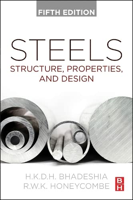 Published 2024 preview, video |
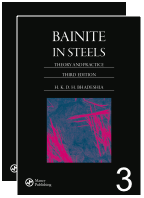 Free download |
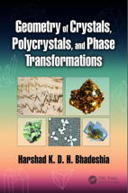 Free download |
 Rails, 2024 |
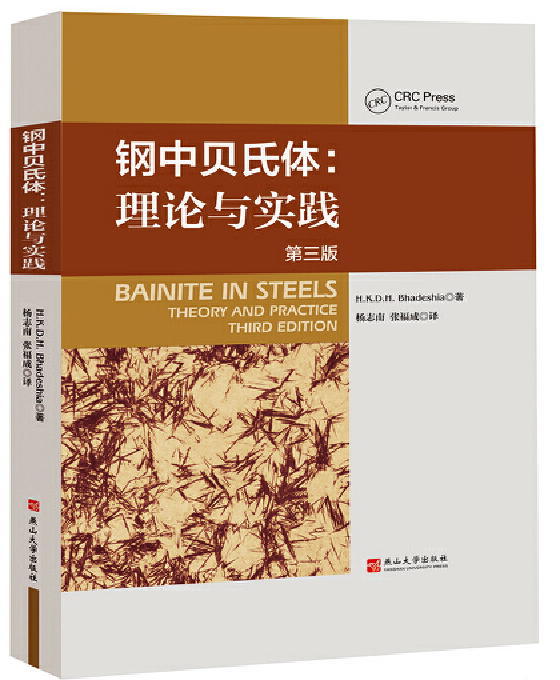 Translation, 2020 |
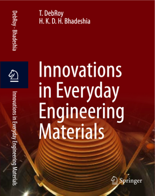 Published 2021 |
| PT Group Home | Materials Algorithms |